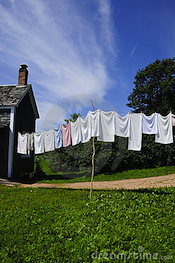7 laundry tips that treat your clothes & our planet gently
The energy that's consumed in manufacturing the clothes we wear is just a part of the story of their environmental impact. According to a Proctor & Gamble study, washing and drying account for 75-80% of the energy consumed during our clothing's life.
 The average household uses 13,500 gallons on nearly 400 wash loads annually—enough to supply a lifetime's worth of drinking water for six people.
The average household uses 13,500 gallons on nearly 400 wash loads annually—enough to supply a lifetime's worth of drinking water for six people.
Here are some ideas to minimize your laundering's impact on our world:
1. Launder Less
Just because you've worn a garment once or twice, it may not need laundering. If you tend to toss lightly worn clothes in the hamper out of habit, stop and reconsider if they can be worn again.
- Use a lint roller or adhesive tape to remove fuzz and pet hair on otherwise clean clothing.
- Deal with spills and stains promptly so you don't have to get heavy-handed with detergents and bleaching agents on washday.
- Hang up clothes that should reside on hangers between wearings. Fold items such as sweaters and knits that are prone to lose their shapes on hangers.
- Dress for a mess. Take the time to change out of your good clothes before engaging in cooking, a little impromptu gardening, or some roughhousing with the kids.
- Apply the sniff test before tossing your clothes in the hamper.
2. Use Cold Water
Heating water accounts for almost 90% of the energy consumed in laundering clothes.
- Use cold-water detergents—they're formulated to clean without hot water.
- Even conventional detergents will often do a good job in cold water. And your clothes will last longer—especially those with elastic and synthetic components.
3. Greener Whites
Resist the temptation to use chlorine bleach—it's highly toxic to you and the planet.
- Instead, try spot cleaning stains and use oxygen bleach products for brightening and whitening. This versatile all-purpose cleaner and stain remover is made from a dried form of hydrogen peroxide that's environmentally friendly. We've used it successfully on everything from clothes to stained sinks to even our grungy and mildewed wood siding and deck.
- Some oxygen bleach products also contain Earth-friendly sodium carbonate. Sold alone as washing soda, it fortifies your detergent to deal more effectively with grease and ground-in stains.
4. Launder Smarter
A little extra effort and attention will pay dividends with clothes that look better and last longer.
- Wash and dry clothes inside-out to minimize wear and fading.
- Believe those care labels—wash similar colors together. Washing that crimson top with your whites is asking for trouble.
- Fasten buttons and close zippers and hooks to prevent abrasion and tangles.
- Wash delicate knits and underwear in mesh bags.
- Full loads are more efficient than partial loads—besides who wants to wash every couple of days?
5. Upgrade Your Washer
If you own a top-loading washer built in the 1990s or earlier, buying an Energy Star-rated front-loading machine will reduce your water consumption greatly.
- Machines earning the Energy Star logo consume 18-25 gallons per load versus the 40 gallons used by older top loaders.
- Some states and utilities will help offset the cost of your purchase with a tax credit or cash rebate. (Sadly, federal tax credits for certain Energy Star appliances ended in 2011. However, they may resume—check the Energy Star website.)
- Modern washers work with high-efficiency (HE) detergents that require smaller quantities of detergent and water. This also reduces the amount of packaging that enters our waste stream.
Anastacia's Tuxedo Top is crafted in the USA from a hemp/Tencel blend. After a busy day, wrinkles melt away in a steamy bathroom.
6. Ditch the Dryer
Line-drying your clothes imparts a freshness and wonderful, natural smell that no perfumed softener can match.
- Some fabrics develop a rather stiff hand when dried outdoors. A few minutes of tumble-drying on a cool setting using several of tennis balls or dryer balls made expressly for this purpose will impart a softer texture and shorten drying time. A cup of vinegar added to rinse water will also help—see 7.
- Invest in a drying rack if you have no suitable outdoor space. They come in handy during wet weather too. Placed near heating sources and well-ventilated spots in your home, your clothes will dry quickly.
- When you must use the dryer, make sure the lint filter is clean, and if equipped with one, use its moisture sensor for more efficient drying.
- Removing clothes from the dryer while still a little damp will not only reduce energy use, it can help you minimize or eliminate ironing since damp clothes can be hand-shaped and smoothed.
- One instance when using a hot dryer can make sense is when you're confronted with wrinkled garments that otherwise might need ironing. Try tumbling them on the highest setting the fabric can handle for a few minutes then put them on hangers to cool down.
- Moderately wrinkled clothes can also benefit from being hung in steamy bathrooms. (That’s especially true of Sympatico’s blended hemp and Tencel fabric.) Using a handheld steamer can also minimize the dreaded chore of ironing.
7. The Dirt on Detergents and Fabric Softeners
Speaking ecologically, commercial laundry detergents are better than they once were. Some no longer contain phosphates and have scaled back on other noxious ingredients. But many of these products—even some that claim to be green and earth-friendly—contain petroleum-based chemicals, dyes, optical brighteners, and fragrances. There are no labeling requirements forcing manufacturers to disclose what's in their detergents.
- Many laundry detergents and stain removers contain alkylphenol ethoxylates (APEs) that help these cleaners to penetrate stains and wash them away. Unfortunately, they also damage our immune system and are suspected hormone disruptors that upset the body's ability to regulate reproduction and development.
- Thankfully, some manufacturers voluntarily reveal their ingredients. The best are derived from renewable plant-based substances and are biodegradable. A little time spent online will help you find the truly eco-friendly brands that avoid the use of toxic and non-renewable chemicals.
- Fabric softeners and dryer sheets contain potentially harmful chemicals and fragrances and they cost a bundle. As an alternative, add a cup of white vinegar to rinse water in place of commercial fabric softeners. It's highly acidic, having a pH factor of about 2.4, thus balancing detergents with their pH factors of 8-10. This results in fluffier towels and softer tee shirts at a fraction of the cost with none of the environmental and health concerns of softeners.





